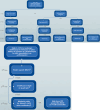First regional consensus on the management of Helicobacter pylori infection in the Middle East
- PMID: 40741103
- PMCID: PMC12305147
- DOI: 10.3748/wjg.v31.i27.107138
First regional consensus on the management of Helicobacter pylori infection in the Middle East
Abstract
Helicobacter pylori (H. pylori), a widespread gram-negative bacterium that colonizes the stomach, causes chronic gastritis, which may progress to peptic ulcer, mucosa-associated lymphoid tissue lymphoma, and gastric cancer. H. pylori infection affects over 50% of people in developing countries and 10%-20% in developed countries. The Kyoto consensus classifies H. pylori gastritis as an infectious disease in the International Classification of Disease 11th Revision. The Maastricht/Florence consensus recommends treatment for all infected individuals, introducing a shift in the management strategies. The prevalence of H. pylori infection is high in the Middle East, with infection rates of 40%-70% and 85%-90% being reported among children and adults, respectively. The increasing resistance to antibiotics, including macrolides and fluoroquinolones, is a major challenge in the management of H. pylori. Clarithromycin resistance, which is associated with reduced effectiveness of standard triple therapy regimens, leading to higher rates of treatment failure, impacts the eradication rates. This emphasizes the need for routine antibiotic susceptibility testing at the national level, the use of alternative therapies, including new molecular methods, and antibiotic stewardship. An online panel of experts from the Middle East, along with an international expert, developed this consensus to provide comprehensive guidelines on the diagnosis, treatment, prevention, and role of gut microbiota in H. pylori infection, with the goal of improving clinical decision-making and reducing the impact of antibiotic resistance in the region. These guidelines are intended to support healthcare professionals involved in the diagnosis and management of H. pylori, including primary care physicians, gastroenterologists, and other specialists. They may also inform future clinical research aimed at optimizing treatment strategies and addressing regional challenges.
Keywords: Antibiotic resistance; Consensus guidelines; Gastric cancer; Gut microbiota; Helicobacter pylori.
©The Author(s) 2025. Published by Baishideng Publishing Group Inc. All rights reserved.
Conflict of interest statement
Conflict-of-interest statement: All authors received honoraria from NewBridge Pharmaceuticals for their participation in the consensus, and Newbridge Pharmaceuticals also covered the fees for CCM, a third-party company.
Figures


Similar articles
-
Genomic insights into the antimicrobial resistance and virulence of Helicobacter pylori isolates from gastritis patients in Pereira, Colombia.BMC Genomics. 2024 Sep 9;25(1):843. doi: 10.1186/s12864-024-10749-6. BMC Genomics. 2024. PMID: 39251950 Free PMC article.
-
Helicobacter pylori and gastric or duodenal ulcer.Prescrire Int. 2016 Jan;25(167):18-23. Prescrire Int. 2016. PMID: 26942258
-
Gastric cancer risk after Helicobacter pylori eradication in gastritis and peptic ulcer: a retrospective cohort study in Japan.BMC Gastroenterol. 2025 Jul 1;25(1):463. doi: 10.1186/s12876-025-04034-3. BMC Gastroenterol. 2025. PMID: 40596880 Free PMC article.
-
Optimum duration of regimens for Helicobacter pylori eradication.Cochrane Database Syst Rev. 2013 Dec 11;2013(12):CD008337. doi: 10.1002/14651858.CD008337.pub2. Cochrane Database Syst Rev. 2013. PMID: 24338763 Free PMC article.
-
Effectiveness of first line therapy for Helicobacter pylori infection in children and adolescents: A multicenter study in the United Arab Emirates.PLoS One. 2025 Aug 28;20(8):e0318315. doi: 10.1371/journal.pone.0318315. eCollection 2025. PLoS One. 2025. PMID: 40875773 Free PMC article.
References
-
- Malfertheiner P, Megraud F, O'Morain CA, Gisbert JP, Kuipers EJ, Axon AT, Bazzoli F, Gasbarrini A, Atherton J, Graham DY, Hunt R, Moayyedi P, Rokkas T, Rugge M, Selgrad M, Suerbaum S, Sugano K, El-Omar EM European Helicobacter and Microbiota Study Group and Consensus panel. Management of Helicobacter pylori infection-the Maastricht V/Florence Consensus Report. Gut. 2017;66:6–30. - PubMed
Publication types
MeSH terms
Substances
LinkOut - more resources
Full Text Sources
Medical

